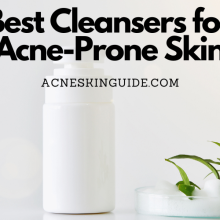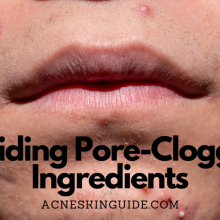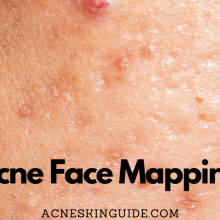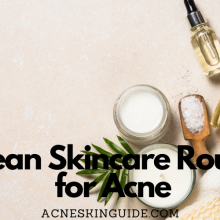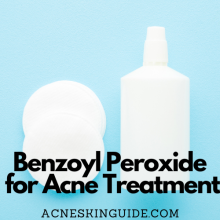Exfoliation for Acne-Prone Skin | Acne Skin Guide
Exfoliation plays a vital role in managing acne-prone skin by removing dead skin cells and debris that clog pores and harbor acne-causing bacteria. There are two main types of exfoliants: physical scrubs and chemical formulas containing acids like salicylic, lactic, and glycolic. For acne, chemical exfoliants are often preferred as they penetrate deeper into pores without causing micro-tears.
An ideal routine involves exfoliating 1-3 times per week, using a mix of chemical and gentle physical exfoliators, and always moisturizing after. Oily skin may benefit from clay masks, while dry skin requires gentler enzymes or lactic acid. Purging is common when starting chemical exfoliants. Professional treatments like peels can provide deeper exfoliation but require downtime. Those with deeper skin tones should use extra caution to avoid irritation and hyperpigmentation. Overall, exfoliation is key for keeping pores clear and allowing acne treatments to work effectively.
#1 Recommended Acne Treatment | #2 Recommended Acne Treatment |
 |  |

The Acne-Fighting Power of Exfoliation: Unveiling Clearer Skin
Struggling with persistent acne breakouts? Don’t overlook the importance of regular exfoliation. This simple skincare step is crucial for managing acne-prone complexions by removing pore-clogging dead skin cells and allowing other treatments to work more effectively.
What Causes Acne?
Acne occurs when excess oil, dead skin cells, and bacteria build up inside pores, causing inflammation and those dreaded blemishes. While hormones are a common trigger, other factors like stress, diet, and certain medications can also lead to breakouts. No matter the cause, keeping pores clear of cellular debris is key to preventing and treating acne.
The Role of Exfoliation
Exfoliation is the process of sloughing off the outermost layer of dead skin cells that naturally accumulate on the surface. For acne-prone individuals, this buildup can bind with oil and bacteria, clogging pores and fueling the cycle of blemishes. Consistent exfoliation creates a clear pathway for other acne treatments to penetrate while removing the environment acne-causing bacteria thrives in.
Types of Exfoliants for Acne
There are two main categories of exfoliants – physical and chemical. Physical exfoliators rely on abrasive ingredients or tools like scrubs, brushes, and microbeads to manually buff away dead cells. Chemical exfoliants such as alpha and beta hydroxy acids dissolve the bonds holding dull surface cells in place.
For acne, chemical exfoliants tend to be preferred as they are less likely to cause irritation or micro-tears that can potentially worsen breakouts. Look for formulas containing salicylic acid, a beta hydroxy acid that cuts through oil to deeply unclog pores. Lactic and glycolic acids are gentle alpha hydroxy acids that exfoliate while providing hydration benefits as well.
Developing an Exfoliation Routine
While tempting to go overboard, exfoliating too frequently or aggressively can actually backfire and damage the skin’s protective barrier against acne-causing bacteria. Most dermatologists recommend exfoliating 1-3 times per week for acne-prone skin using a combination of chemical and gentle physical exfoliants.
Ease into a new exfoliating routine slowly, and always follow with a hydrating moisturizer to replenish the skin’s barrier. You may want to exfoliate less during active breakouts to avoid further irritation.
Be mindful when layering chemical exfoliants with other active acne treatments like retinoids or benzoyl peroxide to avoid excessive irritation and dryness. Certain acne medications like antibiotics can increase sun sensitivity, so be diligent about sun protection if exfoliating during the day.
Targeted Solutions for Different Acne Types
Oily and blemish-prone skin may benefit from oil-absorbing physical exfoliators like clay masks, while dry skin requires ultra-gentle enzyme or lactic acid options. Stubborn cystic acne that develops from hormonal fluctuations often responds well to weekly mandelic acid peels. And don’t forget to exfoliate body acne areas like the back and chest too!
A Common Concern: Purging
When first incorporating a new chemical exfoliant, many people experience an intensified breakout phase known as “purging.” This occurs as existing microcomedones are brought to the surface and is not necessarily a reason to abandon an exfoliant if it is otherwise tolerated well. However, purging that continues for more than 6-8 weeks may indicate the product is too harsh.
Professional Exfoliation Treatments
For a deeper exfoliation, consider adding periodic professional treatments like chemical peels and microdermabrasion into your skincare regimen. A series of medical-grade glycolic or salicylic acid peels can work wonders for clearing out stubborn congestion. Potential side effects like excessive peeling, redness, and sun sensitivity require downtime, so plan accordingly.
Exfoliation Tips for Acne-Prone Skin of Color
Those with deeper skin tones have to take extra precautions when exfoliating to avoid inadvertently triggering hyperpigmentation or discoloration. Look for gentle enzyme exfoliants or very low concentrations of lactic acid rather than harsh scrubs. Hydrating ingredients like honey and yogurt make excellent natural exfoliating masks as well.
Potential Downsides and Precautions
While beneficial when done properly, over-exfoliating is a real risk that can compromise the skin’s barrier and actually worsen breakouts. Don’t exfoliate over active acne lesions and be very careful introducing new exfoliating products, especially if already using prescription retinoids or skin-drying acne medications.
Additionally, some physical exfoliants like microbeads have come under scrutiny for potentially damaging the environment when rinsed down drains. Look for biodegradable jojoba beads or go the chemical exfoliation route instead.
Lifestyle Factors
Exfoliation works hand-in-hand with other positive lifestyle habits for keeping acne at bay. Maintaining a nutrient-rich, low-glycemic diet can reduce inflammation that exacerbates blemishes. Managing stress through exercise, meditation, or other methods is also key as elevated cortisol only worsens breakouts.
Don’t Neglect This Skincare Staple
Exfoliation is an essential component of any skincare routine targeting acne as it clears the way for other treatments to properly penetrate and work effectively. When done safely and correctly, regular exfoliation leaves acne-prone skin smoother and more radiant by removing pore-clogging buildup. So don’t neglect this often overlooked yet crucial skincare step on your journey to clearer skin!
#1 Recommended Acne Treatment | #2 Recommended Acne Treatment |
 |  |
Summary and FAQs
Can exfoliating cause more acne breakouts or irritation?
Yes, exfoliating can potentially cause more acne breakouts or irritation if not done properly. Here are a few reasons why:
- Over-exfoliating: Exfoliating too frequently or too aggressively can disrupt the skin’s protective barrier, leading to dryness, redness, and inflammation – conditions that can worsen acne.
- Using harsh scrubs: Physical exfoliants with rough particles like nut shells, sugar, or poorly-milled exfoliating beads can create micro-tears in the skin when scrubbed too vigorously. This allows acne-causing bacteria to get into the skin more easily and spread existing breakouts.
- Improper removal: Not fully rinsing away exfoliating acids like salicylic acid or physical scrub particles can leave a residue that clogs pores and triggers breakouts.
- Purging: When first introducing a new chemical exfoliant, some people experience an initial breakout period called “purging” as existing clogs are brought to the surface. This can last 4-6 weeks before clearing.
- Individual sensitivity: Some people simply have more sensitive skin that reacts poorly to certain exfoliating ingredients like overly high acid concentrations.
To avoid irritation, it’s important to exfoliate gently and gradually increase frequency, choose formulas appropriate for your skin type, and discontinue use of any products that seem to worsen breakouts. Proper cleansing after exfoliating is also essential.
How does exfoliation compare to other acne treatments like benzoyl peroxide or retinoids?
Exfoliation plays an important complementary role to other topical acne treatments like benzoyl peroxide and retinoids, but it works differently:
Benzoyl Peroxide:
- An antimicrobial that kills the acne-causing bacteria P. acnes
- Also helps dry out excess oil and remove surface bacteria/debris
- Often used as a spot treatment or all-over leave-on product
- Can be drying and irritating for some people
Retinoids (Tretinoin, Adapalene, etc):
- Derived from vitamin A
- Helps unclog pores and clear pre-existing acne lesions
- Normalizes skin cell turnover to prevent clogs
- Used as a long-term preventative treatment
- Can initially cause dryness, peeling, and purging
Exfoliation:
- Mechanically removes the outer layer of dead skin cells
- Keeps pores clear of clogs from accumulating
- Allows other acne treatments to better penetrate
- Should be used consistently alongside other treatments
While benzoyl peroxide and retinoids directly target two main causes of acne, exfoliation acts as a supplementary step to thoroughly clear out pores. By removing built-up debris, exfoliation enhances the effectiveness of those treatments.
However, exfoliation alone is not enough to fully control acne for most people. It works best when rotating chemical exfoliants like salicylic acid with benzoyl peroxide products and retinoids as part of a full acne-fighting routine. Proper hydration and sun protection are also key when using these combined treatments.
Are there any exfoliating ingredients that are better avoided for acne-prone skin?
Yes, there are some exfoliating ingredients that those with acne-prone skin may want to avoid or use with caution:
- Nut shells/pits/seeds
These physical exfoliants have irregular, jagged shapes that can tear and irritate the skin, potentially spreading acne-causing bacteria. Stick to smoother exfoliating beads or go for chemical exfoliants. - Coconut-derived ingredients
Coconut oil, coconut butter, and coconut-based scrubs can be comedogenic (pore-clogging) for some people and may exacerbate acne breakouts. - High concentrations of alcohol
Look for alcohol-free exfoliating toners and peels. High amounts of drying alcohols like denatured alcohol can disrupt the skin’s barrier. - Essential oils
Many popular essential oils like tea tree, lavender, and citrus oils are too potent and can cause irritation, especially if used while exfoliating. - Sodium lauryl sulfate (SLS)
This harsh surfactant can strip the skin when found in face scrubs. Look for exfoliating cleansers with gentler sulfate-free surfactants. - Fragrance
Artificial fragrances are a common skin irritant that can inflame acne-prone skin when combined with exfoliating acids/beads.
As a general rule, look for simple formulas with BHA (salicylic acid) or gentle AHAs like lactic acid. Steer clear of overly complex scrubs with lots of potential pore-cloggers. And always do a patch test when trying any new exfoliating product.
Can exfoliation help reduce acne scarring or hyperpigmentation?
Yes, exfoliation can help reduce the appearance of acne scarring and hyperpigmentation, but it requires consistent and proper use:
For Acne Scars:
- Exfoliation helps remove dead skin cells that can get trapped in acne scars, keeping them from looking as pronounced.
- Chemical exfoliants with alpha hydroxy acids (AHAs) like glycolic acid and lactic acid can help break down the tougher scar tissue over time with regular use.
- Physical exfoliation with finely-milled scrubs may also help smooth out textured scars, but should be done gently to avoid further injury.
- Combining exfoliation with other scar treatments like retinoids and vitamin C can provide better results.
For Hyperpigmentation/Marks:
- Exfoliating helps fade post-inflammatory hyperpigmentation left behind from previous acne lesions faster.
- AHAs are particularly effective at breaking up pigment on the surface of the skin through their exfoliating effects.
- Ingredients like azelaic acid, kojic acid, and hydroquinone work synergistically with exfoliation to interrupt pigment production.
However, exfoliation alone may not be enough to completely eliminate severe scarring or stubborn dark marks. More intensive professional treatments like chemical peels, microneedling, or laser treatments are usually needed.
It’s also important not to over-exfoliate while treating acne scars and marks, as this can actually worsen hyperpigmentation in some cases. Moderation and proper hydration are key when exfoliating for these concerns.
How does age impact exfoliation needs for acne?
Age does play a role in determining ideal exfoliation needs and practices for acne-prone skin. Here’s how it can impact exfoliation:
Teens/Early 20s:
- Younger skin tends to have faster cell turnover and renewal
- Hormonal fluctuations common in teens often leads to oilier skin/acne
- Can typically tolerate more frequent exfoliation, 2-3 times per week
- Chemical exfoliants with salicylic acid are usually recommended over scrubs
- Must be careful not to over-exfoliate and disrupt skin barrier
Late 20s/30s:
- Cell turnover starts to slow down in the mid-to-late 20s
- Hormonal acne may still be an issue for some
- 1-2 times per week exfoliation may be enough
- Should mix chemical and gentle physical exfoliation
- More hydrating ingredients like lactic acid are beneficial
40s and Over:
- Significant decrease in cell turnover rate as skin matures
- Acne less likely to be hormonal, more related to skin aging
- Exfoliation once weekly may be sufficient
- Should avoid overly drying or harsh exfoliants
- Enzyme exfoliants and ultra-gentle lactic acid are ideal
In general, younger acne-prone skin can handle more frequent and stronger exfoliation. As skin ages, the need for exfoliation decreases and the focus shifts more towards hydrating and gentle sloughing of surface cells.
No matter the age, the key is sticking to a consistent routine using well-formulated non-irritating products. Adjustments may be needed based on acne severity and personal skin tolerance as well.

